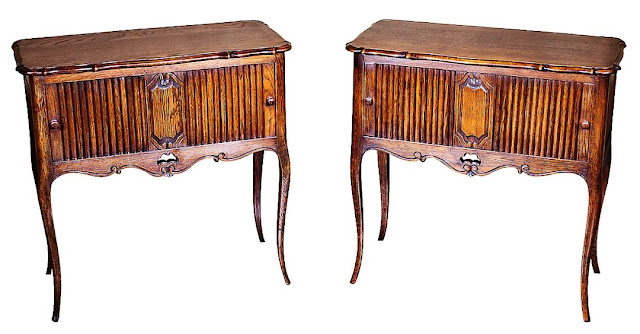TAMBOUR
tam·bour [tam-boo r, tam-boo r]
noun [tam-boo r, tam-boo r]
1. Music. a drum.
2. Architecture. a wall that is circular in plan, such as one that supports a dome or one that is surrounded by a colonnade.
3. Furniture. a flexible shutter or roll front, made with narrow mouldings or strips of wood that are transversely glued onto a heavy canvas or linen backing, the ends of which fit into grooves on the inner sides of the piece of furniture. It may be used as a vertical rolling or horizontal sliding door on a cabinet or chest.
Origin:
1475-85; < Middle French: drum ≪ Arabic tanbūr lute < Medieval Greek pandoúra
The tambour was first used in France in the 1760s when King Louis XV commissioned Jean-François Oeben, Ébéniste du Roi (Cabinetmaker to the King), to create a new type of writing desk for the king's private study that could be shuttered and locked. The desk's appearance and functionality were important to Louis XV, but security was his main concern. Confidential, diplomatic papers would be kept inside the desk's secret drawers and compartments, so a great deal of time was spent making sure the rolling top and mechanical locking devices were theft proof. There was only one key and the King had it in his possession at all times.
The desk, known as the Bureau du Roi (King's Desk), is one of the most famous pieces of furniture ever crafted and one of the most opulent creations of the 18th century. Oeben didn't live to see it completed, unfortunately. He died in 1763 and his protégé, Jean Henri Riesener, was left with the task of finishing the work Oeben had begun. The challenging design and royal history of the iconic desk assured its fame and many 19th century ébénistes attempted to create similar versions.
 |
| Lolo French Antiques et More Item #LFA276 Pair of Louis XV Style Chevets with Tambour Doors |
This pair of chevets with tambour doors is a perfect solution for accessible storage when space is an issue and hinged doors don't work.
 |
| Lolo French Antiques et More Item #LFALO1011 Louis XV Style Bureau à Cylindre |
And this lovely desk is finished on all sides and can float in a room. Imagine all the letters written with pen and paper at this desk. How long ago did you write your last proper letter?
À Bientôt!
Lolo & Mimi
À Bientôt!
Lolo & Mimi
Origin:
1610–20; New Latin, Latin < Greek ákanthos bear's-footACANTHUS a·can·thus [uh-kan-thuh s] noun [uh-kan-thuh s] 1. Plants. any shrub or herbaceous plant of the genus Acanthus, native to the Mediterranean region but widely cultivated as ornamental plants, having large spiny leaves and spikes of white or purplish flowers. 2. Architecture. a design patterned after the leaves of one of these plants, used especially on the capitals of Corinthian columns. Origin: 1610–20; New Latin, Latin < Greek ákanthos bear's-foot
Original Post from: Lolo's French Bloguette http://lolosfrenchbloguette.blogspot.com/search/label/word%20of%20the%20week
Copyright Lolo French Antiques et More - All Rights Reserved
1610–20; New Latin, Latin < Greek ákanthos bear's-footACANTHUS a·can·thus [uh-kan-thuh s] noun [uh-kan-thuh s] 1. Plants. any shrub or herbaceous plant of the genus Acanthus, native to the Mediterranean region but widely cultivated as ornamental plants, having large spiny leaves and spikes of white or purplish flowers. 2. Architecture. a design patterned after the leaves of one of these plants, used especially on the capitals of Corinthian columns. Origin: 1610–20; New Latin, Latin < Greek ákanthos bear's-foot
Original Post from: Lolo's French Bloguette http://lolosfrenchbloguette.blogspot.com/search/label/word%20of%20the%20week
Copyright Lolo French Antiques et More - All Rights Reserved
ACANTHUS
a·can·thus [uh-kan-thuh s]
noun [uh-kan-thuh s]
1. Plants. any shrub or herbaceous plant of the genus Acanthus, native
to the Mediterranean region but widely cultivated as ornamental plants,
having large spiny leaves and spikes of white or purplish flowers.
2. Architecture. a design patterned after the leaves of one of these
plants, used especially on the capitals of Corinthian columns.
Origin:
1610–20; New Latin, Latin < Greek ákanthos bear's-foot
Original Post from: Lolo's French Bloguette http://lolosfrenchbloguette.blogspot.com/search/label/word%20of%20the%20week
Copyright Lolo French Antiques et More - All Rights Reserved
Original Post from: Lolo's French Bloguette http://lolosfrenchbloguette.blogspot.com/search/label/word%20of%20the%20week
Copyright Lolo French Antiques et More - All Rights Reserved



No comments:
Post a Comment